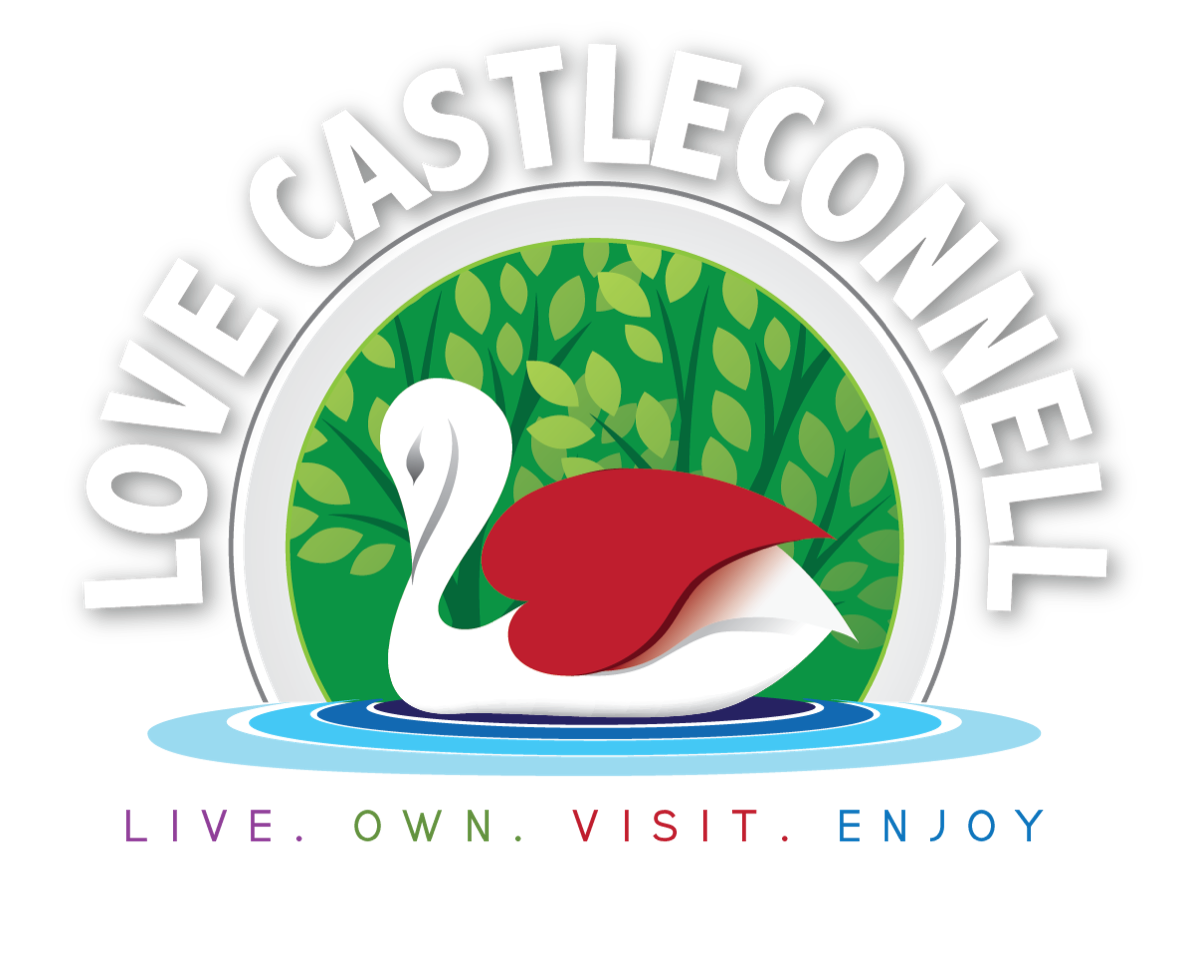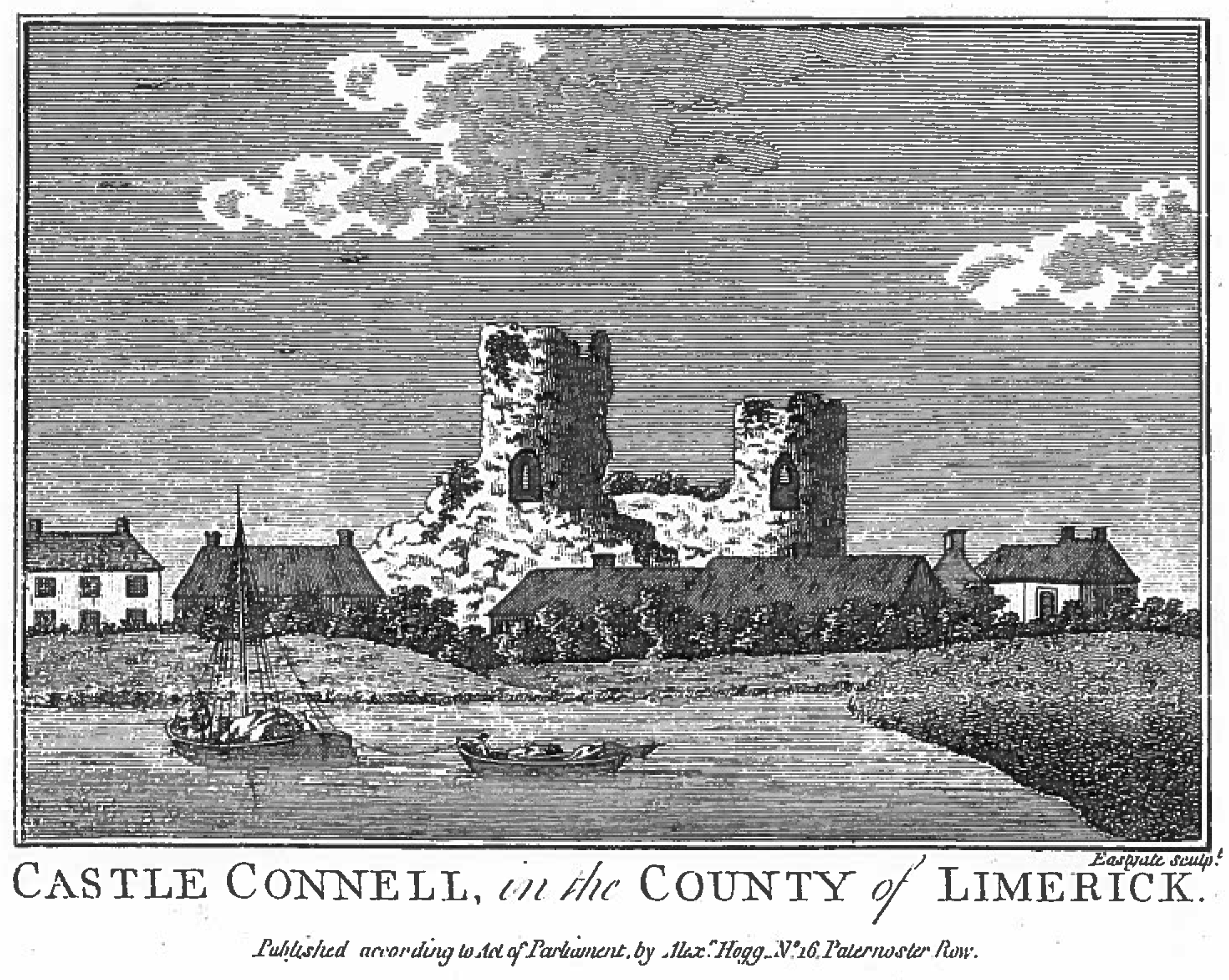By Paddy Tuohy
On a summit of a rock beside the village are the ruins of Castleconnell Castle, now overgrown with moss and lichen. Young ash and sycamore compete with one another thrusting their roots deep within crevices seeking sustenance. The gaunt north-west towers, fragments of the south east gable, a flight of stone steps and some openings that may have once held doors and windows are all that remain of what was, in the days of yore a magnificent fortress by Shannon side.
The story of Castleconnell castle is in itself an epic of great proportions—a story that is spread across seven hundred years of Irish history. It was through the centuries oft the scene of much turbulence and little peace, where violent crimes of murder and mutilation were carried out. Rifts of jealousy and strife and a continuous struggle for power were all part of its chequered existence.
It was erected as a wooden fortress 1,000 years ago by the Gunning family, a Dal Cais family, and their name is still perpetuated in the Irish name for Castleconnell, i.e Caislean O gConaing (Gunning’s Castle) When the O gConaing name was anglicized to that of Connell no-one of that name had ever lived or owned the castle, still the name stuck and so was born the name of Castleconnell.
The Gunnings were soon superseded by the O’Brien family and between them they held the castle for close on two hundred years. In 1174 Dermot O’Brien, a grandson of Brian Boru was occupier of the castle and his nephew Donal Mór O’Brien visited him on his way back from a successful victory at a battle in Thurles. There had for some time been much mistrust between uncle and nephew as Donal Mór believed that Dermot had set his sights on the kingship of Limerick. He visited his uncle Dermot at Castleconnell and availed of his hospitality. But in the middle of the night he attacked his uncle and gouged out his eyes, resulting in his death. He also gouged out the eyes of a kinsman of the O’Briens, one Mahon O’Brien, but he did not die. This was the same Donal O’Brien who subsequently donated his palace as a site for St Mary’s Cathedral in Limerick.
The O’Briens were a powerful family during the first two hundred years of the castle, Brian Boru had become High King of Ireland and had a great victory over the Vikings at the Battle of Clontarf. He would have made enemies amongst the chief Irish families of the day, in his climb to high kingship. However, he Brian, his son Murcadh and his grandson Turlough were all killed in Clontarf. Brian himself was killed by Brudar the Dane.
The O’Brien control ended around the year 1200 with the coming of the Normans in 1169, on the invitation of Diarmuid Mac Murragh King of Leinster. The Normans were great builders of roads, bridges and strong houses or keeps. They established a big centre at Athashel near Golden in Co Tipperary. William was granted Castleconnell Castle by King John with conditions attached. The O’Briens were then superseded by a Norman family De Burgo, De Burgh, or Bourke and they built a stone fortress in the year 1200 and consolidated their position by intermarriage with the O’Briens.
William De Burgh was recognised as the Chief of the Bourkes and the Barony around this region still bears the title of the Barony of Clanwilliam. There were attempts by the O’Brien clan to retake the castle and attempts made by the O’Connors of Connaught to demolish it. William de Burgh was created a peer in 1580 by Queen Elizabeth 1st with the title Lord Baron Bourke the 1st of Castleconnell, because his two sons were killed fighting for Elizabeth’s side in a battle at Barrington’s Bridge. The De Burgh family had much property and castles in Ireland, in Galway, Mayo, on the banks of the Suir in Tipperary and at Brittas near Boher, Co. Limerick. They sided with the Geraldines in the Geraldine War against Elizabeth in the sixteenth century and suffered for their efforts when some of their property was confiscated. However, when Sir Henry Sidney, the Lord Deputy visited Limerick in 1575, the De Burghs came and made their submissions and were restored to the Queen’s favour and confirmed in their estates. Four years later when the Spaniards arrived at Smerwick Bay in Co. Kerry, James Fitzmaurice, a Desmond chief tried to induce William De Burgh to come to their assistance but he refused and remained staunch to the promise he had made to Sir Henry Sidney some years previously. Enmity developed between the Desmonds led by Fitzmaurice and the De Burghs and many skirmishes occurred between them resulting in loss of life although they were connected through marriage. Within twenty six years, six of the sons and grandsons of Sir William Bourke all died with sword in hand and five direct descendants of James Fitzmaurice the 15th Earl of Desmond were also killed fighting the Desmond cause.
When William of Orange came to Ireland and Limerick became the subject of two successive sieges in 1690 and 1691. The castle was attacked in 1690 and the Bourkes surrendered, 126 prisoners were taken. The first siege was lifted and the Williamites withdrew from the castle, the Bourkes re- possessed it and held it until the following year, but this time when Ginkell, William’s lieutenant’s troops were besieging Limerick, the Prince of Hesse, with his own regiment of 700 horses and five pieces of cannon attacked the castle and demolished it.
In all there were nine Lord Castleconnells, the last one named Thomas died while fighting with the Wild Geese in Sardinia. He was the last direct line of the De Burgh of Clanwilliam. The De Burghs had held control of the castle for almost 500 years. One Richard De Burgh died in 1760, without issue and bequeathed his estate to Chief Baron Hussey who adopted the name De Burgh.
During the famine years the Lady of the house, Lady De Burgh now residing in the Island attached to the Castle gave money and assistance to the laying of a famine road which to this day bears her name. It is called Lady’s Road and enters the Bog near the Sandpit Hill and exits opposite the tile factory on the old N7 near the Tipperary county boundary. In 1866 the ground landlord of the estate was Richard Donnelan De Burgh and he was instrumental in the financing and organising the laying of the railway track from Ballysimon to Birdhill, servicing Castleconnell. It was completed before time and under cost. It is still there and in service, a monument to the foresight of the De Burgh family.
The estate was bought out under different Land Acts such as the Ashbourne and the Windbourne Acts. The Land Commission acquired it and it was divided out among the tenants on a rental basis paid twice yearly in May and November.
The castle was finally blown during the second Siege of Limerick in August 1691. It lies today as it fell, a disintegrated and confused mass of masonry, stone and debris save for the remnants of its towers and some lesser features. There is little to indicate the size, splendour and importance of this once great Anglo Irish Fortress.
During the 1800s a road making company from Co. Offaly were contracted to make roads around the village, they used stones from the rubble of the fallen castle in the roadmaking. That road today cuts through the ruined rubble leaving a large mound of masonry divided from the main ruin and can be seen across the road from the entrance to the castle grounds. It too is overgrown with ivy, moss and lichen. It was rumoured strongly that the contractor in working through the rubble found gold. The ruin is now in private ownership.
Castles high fall in decay
And Lords that once did hold them
Lords and castles pass away
Like our beads when we have told them.
This article is part of a talk which I delivered in Bradshaw’s Bar during the summer as part of the Love Castleconnell Festival, at the request of Padraig Power. I would like to thank both Pádraig and Margaret for their hospitality

